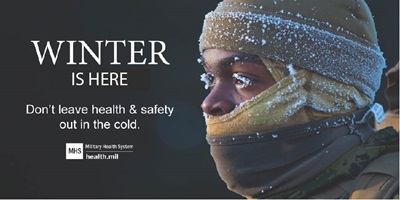Dear Doc: Although my gym has opened back up, I’m still a little hesitant to return because of the recent spikes in COVID cases in my area. I’ve been getting creative with my home workouts, and I’d really like to be outside more, but it’s so cold! I want to bundle up, but I don’t want to overdo it and get overheated. Do you have any recommendations for dressing for outdoor workouts in the winter?
–Working Out in a Winter Wonderland

Dear WOiaWW: I can assure you that you’re not the only one struggling with this! Staying physically fit isn’t just important for readiness; it’s a lifesaver for people fighting off both winter and COVID blues. I talked to Army Lt. Col. Chad Hulsopple, assistant professor of family medicine at the Uniformed Services University of the Health Sciences and director of the National Capital Consortium’s Sports Medicine Fellowship, and here’s what he had to say:
When the temperature starts to drop outdoors and the days begin to shorten, many people turn to indoor exercise. Some adventurous athletes enjoy extreme cold-weather activities such as a polar plunge or running 350 miles in subzero temperatures during the Iditarod Trail Invitational. However, most people are not that adventurous and just want to maintain their regular exercise and can struggle to maintain their exercise routines while indoors. Outdoor exercise routines can still be enjoyed in cold weather environments with the appropriate pre-planning and exercise precautions.
Icy, snowy, and wet conditions can result in rapid cooling of the body and injuries from slips and falls. Avoid overdressing and materials with cotton, which can result in excessive sweating and sweat retention, respectively. The body can lose heat 25 times faster with wet skin. A good rule of thumb is to be slightly cool when starting your exercise to avoid overheating. Multiple layers allow temperature control by removing and adding layers throughout your workout to maintain comfort.
Also consider waterproof breathable shoes and gaiters to decrease the likelihood of getting your feet wet. There are commercially available traction cleats for additional grip on snow and ice.
Prevent large amounts of heat loss through the head, neck, and extremities with stocking caps, gloves, and moisture-wicking socks. Neck gaiters and balaclavas can help prevent heat loss and skin exposure of the face and neck. Some cold-weather environments might require thicker socks with insulating and moisture-wicking properties. You might need to increase your shoe size to accommodate these socks.

Consider at least three loose clothing layers – moisture-wicking base layer, insulating mid-layer, and a breathable wind and waterproof outer layer.
Cold weather injuries can include hypothermia, frostbite, and non-freezing cold weather injuries. Many of these conditions can occur in temperatures above freezing due to an individual’s skin becoming wet.
Take all precautions and monitor the wind chill index to determine the relative risk of these injuries before venturing outside in the cold weather. If you experience a tingling or numbness, skin color changes, mental status changes, excessive shivering, and/or poor or uncontrolled body movements, these can be signs of cold-weather injuries, and you need to seek immediate medical assistance and a warm shelter. Do not stay in the cold weather and avoid re-exposing yourself to cold weather once in a warm environment.
WOiaWW, I hope this helps you make some wardrobe choices that will keep you warm – but not too warm – and makes you feel a little better about getting your workouts in during the winter. Spring will be here soon enough.
Until then…take care out there!
–Doc